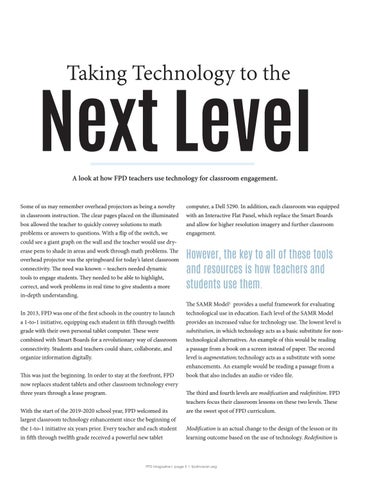Taking Technology to the
Next Level A look at how FPD teachers use technology for classroom engagement.
Some of us may remember overhead projectors as being a novelty in classroom instruction. The clear pages placed on the illuminated box allowed the teacher to quickly convey solutions to math problems or answers to questions. With a flip of the switch, we could see a giant graph on the wall and the teacher would use dryerase pens to shade in areas and work through math problems. The overhead projector was the springboard for today’s latest classroom connectivity. The need was known – teachers needed dynamic tools to engage students. They needed to be able to highlight, correct, and work problems in real time to give students a more in-depth understanding. In 2013, FPD was one of the first schools in the country to launch a 1-to-1 initiative, equipping each student in fifth through twelfth grade with their own personal tablet computer. These were combined with Smart Boards for a revolutionary way of classroom connectivity. Students and teachers could share, collaborate, and organize information digitally. This was just the beginning. In order to stay at the forefront, FPD now replaces student tablets and other classroom technology every three years through a lease program. With the start of the 2019-2020 school year, FPD welcomed its largest classroom technology enhancement since the beginning of the 1-to-1 initiative six years prior. Every teacher and each student in fifth through twelfth grade received a powerful new tablet
computer, a Dell 5290. In addition, each classroom was equipped with an Interactive Flat Panel, which replace the Smart Boards and allow for higher resolution imagery and further classroom engagement.
However, the key to all of these tools and resources is how teachers and students use them. The SAMR Model1 provides a useful framework for evaluating technological use in education. Each level of the SAMR Model provides an increased value for technology use. The lowest level is substitution, in which technology acts as a basic substitute for nontechnological alternatives. An example of this would be reading a passage from a book on a screen instead of paper. The second level is augmentation; technology acts as a substitute with some enhancements. An example would be reading a passage from a book that also includes an audio or video file. The third and fourth levels are modification and redefinition. FPD teachers focus their classroom lessons on these two levels. These are the sweet spot of FPD curriculum. Modification is an actual change to the design of the lesson or its learning outcome based on the use of technology. Redefinition is
FPD Magazine I page 5 I fpdmacon.org
